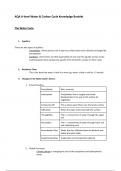Summary
Summary AQA A-level Water & Carbon Cycle Revision Notes
- Institution
- AQA
Detailed notes for the entire Water and Carbon Cycle topic of AQA A-level Geography, organised in order of the syllabus. The theories are applicable to all case studies, however the two I have chosen and explored deeper in these notes are The Amazon Rainforest and River Exe. These case studies allo...
[Show more]



